

Vol. 39 (Number 33) Year 2018 • Page 28
Subhankar DAS 1; Subhra Rani MONDAL 2; Kalyan Kumar SAHOO 3; Anand NAYYAR 4; Kamakshaiah MUSUNURU 5
Received: 06/05/2018 • Approved: 30/05/2018
3. Objectives & research methodology
ABSTRACT: This study aims to establish whether the socioeconomic factors of Facebook users has a varying influence on their buying decisions after exposing to advertisements on it. The study was conducted on 865 respondents of Odisha (430 male & 435 female) of which 445 were rural & 420 were urban. The data was analyzed by applying linear regression along with MANOVA. Two of the packages namely R base along with diagram were used to perform linear regression and for visualization. The study takes gender, age, education, marital status, residence, occupation & income as socioeconomic factors and these are pitted against study variables like mode of shopping, frequency of purchase, amount spent & types of goods purchase. The study highlights the significant relationship between the socioeconomic factors & these study variables. |
RESUMEN: El objetivo de este estudio es establecer si los factores socioeconómicos de los usuarios de Facebook tienen una influencia variable en sus decisiones de compra después de exponerlos a anuncios publicitarios. El estudio se realizó en 865 encuestados de Odisha (430 hombres y 435 mujeres), de los cuales 445 eran rurales y 420 eran urbanos. Los datos se analizaron aplicando una regresión lineal junto con MANOVA. Dos de los paquetes, a saber, la base R junto con el diagrama, se usaron para realizar una regresión lineal y para la visualización. El estudio considera el género, la edad, la educación, el estado civil, la residencia, la ocupación y el ingreso como factores socioeconómicos y estos se enfrentan a variables de estudio como el modo de compra, la frecuencia de compra, el monto gastado y los tipos de compra de bienes. El estudio resalta la relación significativa entre los factores socioeconómicos y estas variables de estudio. |
Advertising is the non-personal communication of the information usually paid for and persuasive in nature about products, services or ideas by identified sponsors through the various media (Datta, 2008). The advertiser intends to spread his ideas about the products and offerings among the prospects. Popularisation of products is thus the basic aim of advertising (Ramaswami & Namakumari, 2004). With advent of digital media this advertising goes to next level from mass media to social media. The social Web is changing the facets of traditional marketing communications. Traditional brand communications that were previously controlled and administered by brand and marketing managers are gradually being shaped by consumers. The rapid growth in popularity of social media platforms in recent years has raised the question of whether this phenomenon has reduced marketers’ control of brand management (Berthon et al. 2007). During the social media age, knowledge of both the influence of company created communication on consumer perception of brands & the influence of consumer online content creation on brands is important (Berthon, Pitt, and Campbell 2008; G. Christodoulides 2009). Social media platforms like Facebook offer an opportunity for consumers to interact with other consumers; thus, companies are no longer the sole source of brand communication (Li and Bernoff 2011). Moreover, consumers are increasingly using social media sites to search for information and turning away from traditional media, such as TV, radio and magazines (Magold and Faulds 2009).
Social media like Facebook are gaining popularity and are increasingly used in regular operations of many companies, ranging from start-ups and SMEs to large corporations (Lee et al, 2008; Osimo, 2008; Andriole, 2010; Bell and Loane, 2010). Despite extensive use of Facebook, little is known on the specific impact that these tools & technologies have on business process performance (Denyer et al, 2011).
This paper tries to highlight the very important factors of consideration on the buying decision of consumers who are mainly using Facebook as a tool of information for brand through advertising along with how they perceive & are influenced by advertisement of the products on it. This paper tries to fill the gap in literatures which are a few or absent in highlighting the importance of socioeconomic factors of Facebook users on their purchase decision.
Vast use of Facebook around the globe has made it a new and important advertising platform, where businesses place their ads to reach their prospective customers. This is probably because Facebook allows businesses to target specific customer and promoting their product or services through effective advertisements. As Vahl (2011) argues Facebook is facilitating the manufacturers and service providers to reach customers of specific age group and interest. Growing Facebook based advertising is perhaps an indication that it is becoming an important source of business presentation and the firms are taking Facebook advertisement as a useful strategy to attract customers. Just in a few years, it has become a part of promotional mix of the firms to create awareness in target areas and influence customers mind. Because of its popularity, businesses are placing their ads on Facebook for creating awareness and influencing buying behavior. Some businesses like HP, have adopted Facebook as a crucial part of business activities to stay close with customers in competitive business environment. Vahl (2011) highlights the businesses magnetism towards Facebook and mentions that Facebook revenue from businesses advertisements reached approximately $ 5.6 billion in 2016.
Companies are spending a sizable portion of their budget on advertising their products and services. Through the advertisements which accompany interesting information, firms attempt to influence customers’ buying behavior favorably. Facebook is also being used for the very reason as the firms believe that their advertisement may catch customers’ attention and action (favorable purchase decisions).
Companies struggle to differentiate their products and services to create values for their customers. Advertising is used to create products / services differentiation in customers’ mind (Hussainy et al., 2008). Advertisers are aware of the importance of brand value development strategy and the benefits it may offer by effectively influencing customers’ mind. This is because often customers have association with specific brands and emotional values these brands have for them. This urges the advertisers to create emotional values for their viewers through advertisement on the media like Facebook.
Advertising is the core idea that is presented in non-personal ways to create purchase intention. Srinivasa (2008) define advertisement as “the sharing of information about products in a non-personal way usually paid by a sponsor through different media”. Similarly, Ayanwala et al., (2005) define it as “a non-personal paid form of communication, where ideas, concepts, products or services, and information, are promoted through media (visual, verbal, and text) by an identified sponsor to persuade or influence behavior”. Bishnoi and Sharma (2009) emphasized the inherent characteristics of advertisement and suggested that popularity is the aim of advertisement.
Facebook is type of social media, where people with common interest shares their ideas and comments in a virtual environment (Weber, 2009). Facebook advertising enables customers to share their experience, ideas, interest and useful information about a brand. Facebook advertising is useful in the sense that it is interactively helpful in collecting feedback and demographic information of targeted customers. In current business environment, Facebook advertising is an effective source to reach targeted customers (Sendberg, 2010). Facbook advertising provides the opportunity to build up your brand and engages with customers on a large social network.
Facebook advertising is done to create likeness, attraction and influence buying behavior in positive way. Attitude-towards-the ads, is an interesting theory of advertising often used to understand the buying behavior. Effective advertisement influences the attitude towards brand and finally leads to purchase intention (Goldsmith & Lafferty, 2002). Ideally, consumers buying behavior is the products purchase decision (Adelaar et al., 2003).
Social media particularly Facebook has become a marketing channel to reach target market. According to a study, “Expand your Brand Community Online” social media has become a significant marketing channel to reach directly targeted customers and engages them with company brands (Hanlon et al., 2008). For example, Audi (German automobile company) and Dunkin’ Donuts (American consumers’ product company) are using social media for direct interactions with customers. Audi has established corporate relations with their fans on Facebook (Wasserman, 2011). Similarly, Proper Cloth, New York based company, has created its page on Facebook to post news of their business and pictures of clothes. All its Facebook fans receive their updates in seconds on their Facebook pages. These leading brands have collected consumers on a single platform (i.e Facebook) and keep them updated at lower cost.
According to Lukka and James (2014) Facebook is an effective source to market your products in a personal way. Facebook has enabled marketers to customize their advertisements for a specific group of people. Marketers target these individuals on the basis of demographic information’s and mutual interest. Facebook has made it possible to reach these targeted people in cost effective and interesting way instead of traditional marketing channels.
There is a research gap exists which this paper tries to highlight i.e. no study highlights the socioeconomic make up or profiles of Facebook users collectively that influence the purchasing behavior. So, this study will definitely bring out more clarity to the existing literatures and help in establishing more credibility.
The followings are objectives to the study. All the objectives are specifically based on Facebook users profile. The study variables are mode of shopping, frequency of purchase, type of goods purchased and amount spend for purchasing of goods.
The research is action-based research as such the work falls in the ambit of applied research methods. The study has two main constructs namely socioeconomic behavior of Facebook users and purchasing behavior. The first construct represented by seven variables viz. Gender, Age, Education, Marital Status, Residence, Occupation and Income. The second construct is influenced by four variables viz. mode of shopping, frequency of purchase, type of goods purchased and amount spent on purchasing. The following table shows details regarding study constructs and related variables.
Table 1
Study constructs and variables
Construct |
Variable |
Socioeconomic Profile |
Gender |
Age |
|
Education |
|
Marital Status |
|
Residence |
|
Occupation |
|
Income |
|
Purchase behavior |
Mode of Shopping |
Frequency of purchase |
|
Types of Goods Purchased |
|
Average amount spent on Goods Purchased (INR) |
All variables related to socioeconomic profile are independent variables and rest of the variables are study variables. For instance, Gender is independent variable and Mode of Shopping dependent variable. So, the regression equation for this relation could be as follows;
Mode of Shopping Behavior= ∝ + β (Gender)+e eq. 1
The hypothesis for this regression equation could be
Ha: Gender influences mode of shopping
The null hypothesis obviously turns out to be “gender doesn’t influence mode of shopping”. For a composite hypothesis please look at eq. 7 below.
For this study a multi stage sampling method was adopted. The study is comprised of four districts of Odisha which were selected based on good internet connectivity. For the study a comprehensive questionnaire was constructed covering 14 variables related to impact of Facebook advertising. Besides socioeconomic variable related questions about the respondents, different issues related to the purchasing decisions were also addressed. While conducting the survey, due care was given to the respondents of different walks of life who are well versed with Facebook advertisements are targeted. A total of 1000 questionnaires (250 in each district) were administered through Facebook and WhatsApp groups. A total of 865 questionnaires were considered to be fit for the analysis.
This section brings emphasize on hypothesis for the study. The aim of the research is to find and assess the impact of socioeconomic profile of Facebook users on various traits of purchasing behavior namely mode of shopping, frequency of purchase, type of goods purchased, and amount of money spend over purchasing goods.
H1: Socioeconomic profile of Facebook users impact mode of shopping.
H2: Socioeconomic profile of Facebook users impact frequency of purchase.
H3: Socioeconomic profile of Facebook users impact type of goods purchased.
H4: Socioeconomic profile of Facebook users impact money spent on purchase.
Given the aim and the objectives the study needs linear regression along with MANOVA to test the hypotheses. Each hypothesis needs a simple linear regression in order to get tested. Whereas, to test the multivariate variance the study might need MANOVA. The methods could be as below:
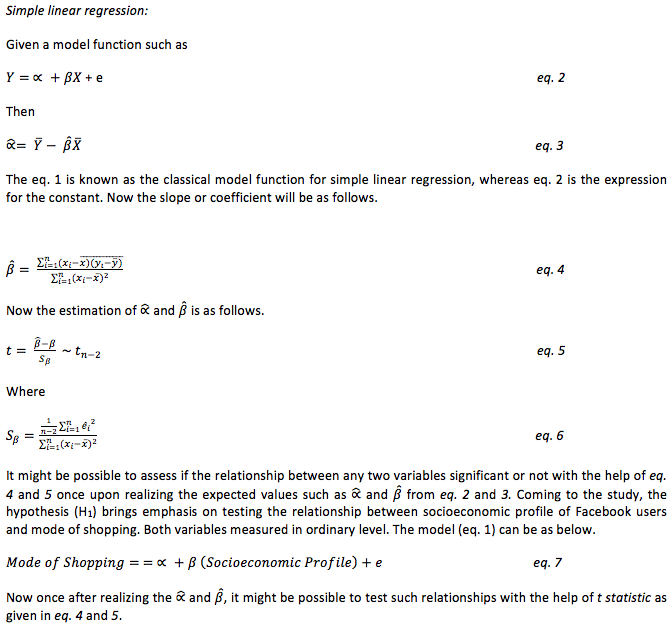
Statistical tools are very important for statistical analysis. Two of the packages namely R base along with diagram were used to perform linear regression and for visualization. R base has sufficient mechanisms to perform linear regression analysis. However, the package diagram is used to plot the structure diagrams. The structure diagram is composed of set of nodes for both dependent and independent variables. The nodes were shown as rectangles and relationships were shown with single headed arrows. The color of the arrow represents significance of relationship. The relationship is deemed to be significant if the color of the arrow is red otherwise not.
The analysis is organized by the output obtained through R for simple linear regression. The data first verified to check normality of the data. Shapiro-Wilk test is chosen to test the multivariate normality of the data. Every model i.e. regression line has two outcomes i.e. the first is the regression output and the second is a visual. The regression output has certain important statistics along with P Values. The P Values were interpreted at respective significance levels.
The following is the normality test.
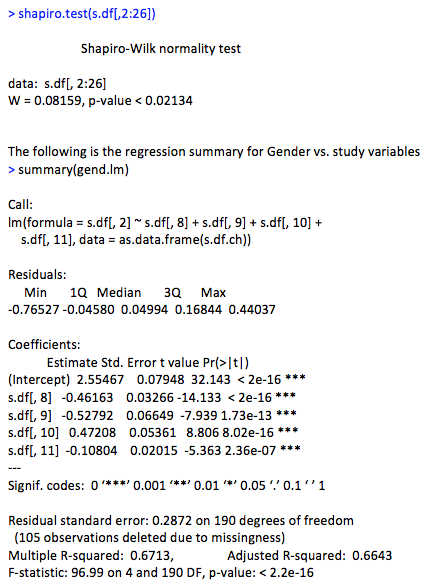
Figure 1
Structure diagram for Gender vs. study variables
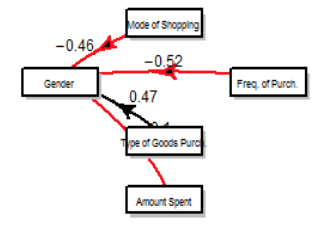
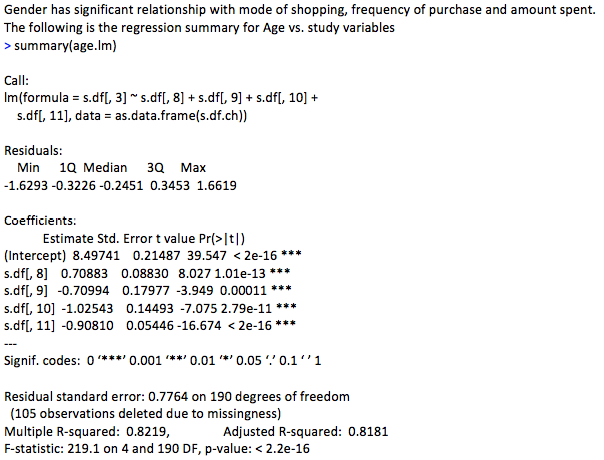
Figure 2
Structure diagram for Age vs. study variables
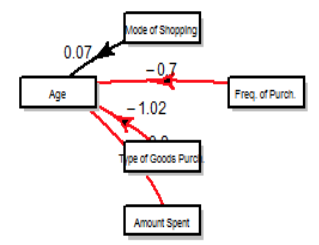
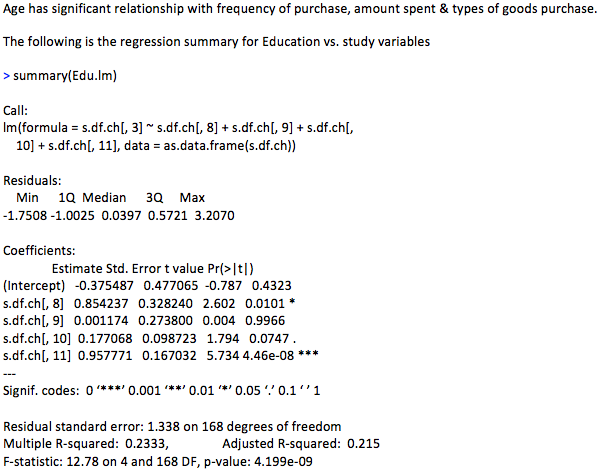
Figure 3
Structure diagram for Education vs. study variables E
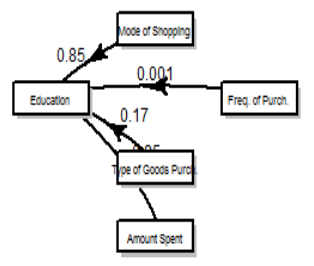
Education has no significant relationship with mode of shopping, frequency of purchase, types of goods purchase & amount spent.
The following is the regression summary for Marital Status vs. study variables
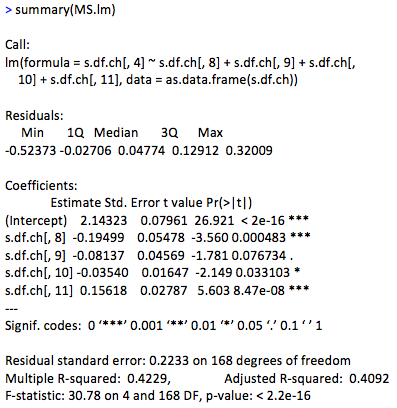
Figure 4
Structure diagram for Marital Status vs. study variables
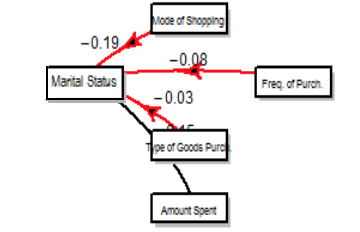
Marital status has significant relationship with mode of shopping , frequency of purchase 7 types of goods purchase.
The following is the regression summary for Residence vs. study variables
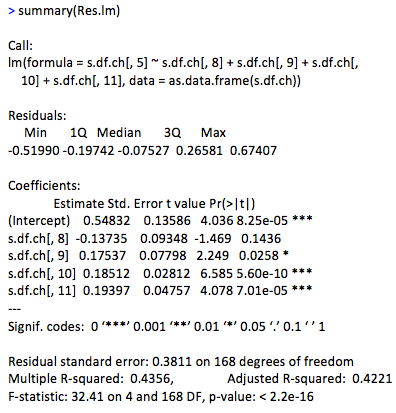
Figure 5
Structure diagram for Residence vs. study variables
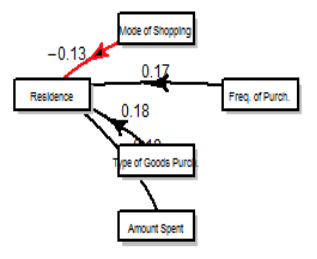
Residence of users has only significant relationship with mode of shopping.
The following is the regression summary for Occupation vs. study variables
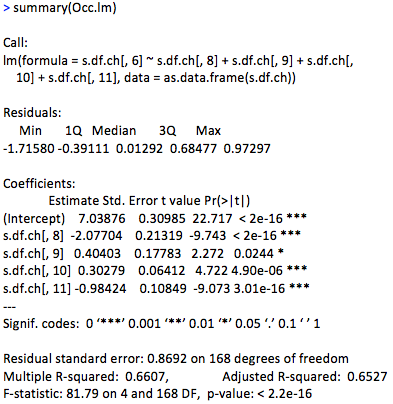
Figure 6
Structure diagram for Occupation vs. study variables

Occupation of users has significant relationship with mode of shopping and amount spent.
The following is the regression summary for Income vs. study variables.
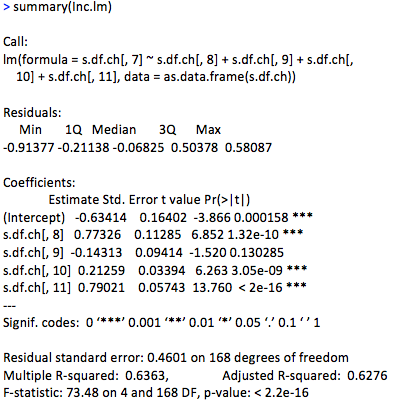
Figure 7
Structure diagram for Income vs. study variables
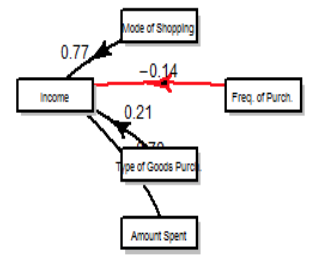
Income has significant relationship with frequency of purchase only.
The study suggests that gender, age & marital status are those socioeconomic profiles mostly affected by highest number of study variables. Residence, occupation are moderately affected by study variables. Income of respondents is affected by only frequency of purchase whereas education of respondents is not affected by the study variables. This is highlighting the fact that education plays a very little role in Facebook profiles of consumers. Facebook use is not at all affected by education also the advertisements are viewed mostly by word of mouth publicity or sharing and forwarding of messages.
This study is only highlighting the socioeconomic profiles of Facebook users, so it can also have extended to other social media platforms to know the reality. Also, this study is done in a smaller geographical region. It can also be done on a larger region if resources permit. Further research is needed by inclusion of all popular social media and coverage of all major dimensions of purchasing behavior.
Adelaar, T., Chang, S., Lanchndorfer, K. M., Lee B., & Morimoto M. (2003). Effects of Media Formats on Emotions & Impulse Buying Behavior. Journal of Information Technology, 18, 247–266.
Andriole SJ (2010). Business impact of Web 2.0 Technologies. CACM, 53(12), 67-79.
Ayanwale, A. B., Alimi, T., & Ayanbimipe, M. A. (2005). The Influence ofAdvertising on Consumer Brand Preference. Journal of Social Science, 10(1), 9-16.
Bell J, Loane S (2010). “New Wave” Global Firms: Web 2.0 and SME Internationalisation. J of Marketing Management, 26(3-4), 213-229.
Berthon, P.R., L. Pitt, and C. Campbell. 2008. Ad Lib: When Customers Create the Ad. California Management Review 50, no. 4: 6-31.
Berthon, P.R., L.F. Pitt, I. McCarthy, and S.M. Kates. 2007. When Customers Get Clever: Managerial Approaches to Dealing with Creative Consumers. Business Horizons 50, no.1 (January): 39-47.
Bishnoi, V. K., & Sharma, V. (2009). The Impact of TV Advertising on Buying Behaviour: A Comparative Study of Urban and Rural Teenagers. JK Journal of Management & Technology, 1(1), 65–76.
Christodoulides, G. 2009. Branding in the Post-internet Era. Marketing Theory 9, no.1 (March 1): 141-144.
Datta Srinivasa (April, 2008) “Advertisements Do They Match Consumer Preferences?” Marketing Mastermind, pp. 59-62
Denyer D Parry E, Flowers P (2011). Social, open, and participative? Exploring personal experiences and organisational effects of Enterprise 2.0 use. Long Range Planning, 44(5/6), 375-396.
Goldsmith, R. E., & Lafferty, B. A. (2002). Consumer response to websites & their influence on advertising effectiveness. Internet research. Journal of Electronic Networking Application and Policy, 12(4), 318-328.
Hanlon, P., & Hawkins, J. (2008). Expand you brand community online. Advertising Age, 79(1), 14-15. Retrieved from: http://proxy.foley.gonzaga.edu:2048/login?url=http://search.ebscohost.com/login.aspx?direct=true&db=ufh&AN=28225980&site=ehost-live
Hussainy, S. K., Riaz, K., Kazi, A. K., & Herani, G. M. (2008). Advertising Styles Impact on Attention in Pakistan. KASBIT Business Journal, 1(1), 28-38.
Li, C., and J. Bernoff. 2011. Groundswell: Winning in a World Transformed by Social Technologies. Boston M.A.: Harvard Business Review Press.
Lee SH, DeWester D, Park SR (2008): Web2 opportunities for small businesses. Service Business, 2(4) 335-345
Lukka, V., & James, P. T. J. (2014). Attitudes toward Facebook advertising. Journal of Management and Marketing Research. 14, 1-26.
Mangold, W.G., and D.J. Faulds. 2009. SocialMedia: The New Hybrid Element of the Promotion Mix. Business Horizons 52, no. 4 (July): 357-365.
Osimo D (2008): Web 2.0 in government. EC Research Center Scientific & Technical Reports.
Ramaswami, V.S. and Namakumari, S. (2004), Marketing Management, 3rd Edition, MACMILLAN, India.
Sandberg, S. (2010). The Role of Advertising on Facebook. Retrieved March 25, 2014, from https://www.Facebook.com/notes/Facebook/the-role-of-advertising-on- Facebook /403570307130
Srinivasa, D. (2008) “Advertisements Do They Match Consumer Preferences?”Marketing Mastermind, pp.59-62.
Vahl, A (2011). Create EPIC Facebook Ads. Publication of Hubsport.
Wasserman, T. (2011). Audi has the most engaged fans on Facebook. Mashable. Retrieved from http://mashable.com/2011/04/22/audis-Facebook -bieber/.
Weber, M. (2009). Marketing To The Social Web: How Digital Customer Communities Build Your Business. (Second Edition). New Jersey: John Willey & Sons Inc.
1. Research Scholar in Faculty of Management Studies, IBCS. SoA (Siksha ‘O’ Anusandhan University), Bhubaneswar, India. Corresponding author. Email: info.subhankardas@gmail.com
2. Research Scholar in Faculty of Management Studies, IBCS. SoA (Siksha ‘O’ Anusandhan University), Bhubaneswar, India. Email: subhra.mondal05@gmail.com
3. Dean King’s Business School, Ghana. Email: kalyan46@rediffmail.com
4. Graduate School, Duy Tan University, Da Nang, Vietnam.Email: anandnayyar@duytan.edu.vn
5. Assistant Professor, GITAM University. Email: kamakshaiah.m@gmail.com